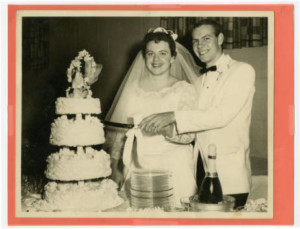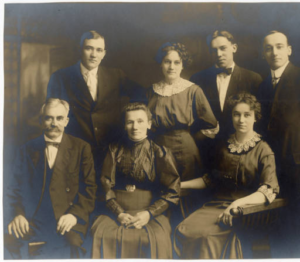When my oldest brother was a toddler, my grandfather would prop him up on his lap and spoon feed him a concoction he liked to call “coffee soup.” It was made from soaking soda crackers in sugary coffee. My grandfather lived through the depression and dishes like this were popular because they made the most out of a few kitchen staples when times were tough. Grandpa Harold passed away before I was born but the coffee soup story just happens to be one of my brother’s favorite memories to share.
 I heard so many stories of my grandfather’s exploits growing up that he became sort of a folk hero in the family. I’m grateful to be a part of a family of fantastic storytellers. In fact, every time my family is together we tell stories. We dig up our most precious, most hilarious and special memories and recount them together. The facts may change as we age and our memories fade, but we all work together to put the important moments of our lives into context and bond over our shared history.
I heard so many stories of my grandfather’s exploits growing up that he became sort of a folk hero in the family. I’m grateful to be a part of a family of fantastic storytellers. In fact, every time my family is together we tell stories. We dig up our most precious, most hilarious and special memories and recount them together. The facts may change as we age and our memories fade, but we all work together to put the important moments of our lives into context and bond over our shared history.
I never realized the true value of these stories until recently. Research has shown some surprising psychological benefits to family story telling, particularly with the younger generation, but the advantages last through all stages of life. Stories that focus on overcoming or facing challenges build resilience and fortitude when we are faced with difficulties of our own. Strong family narratives have been shown to help mitigate both stress and anxiety during tough situations.1 They help us to form our identities and find a sense of belonging.
Right now, as we manage the challenges presented by COVID-19, many of us are searching for ways to connect and make meaningful use of the time spent with family members. One way to do this is to plan some multi-generational bonding through sharing your family story. Stories can be told almost any time and in any place. Even mundane activities, like car rides, can be opportunities to share a story. If you are looking for some inspiration here are a few storytelling project ideas you may want to try with your family.
Interview a family member
Interview a family member and record their story to pass along for generations. With just a little preparation and time you can uncover the challenges, triumphs and adventures that make up your family member’s life story. If you need help, the UCLA library has a Conducting Oral Histories with Family Members guide. This is a fantastic resource for each step of the project from preparing for the interview, organizing questions and making a recording.
Family Tree Magazine has a list of 20 open-ended questions to ask your relative during a family history interview. For an even more extensive interview, the My Heritage Blog has a list of 117 questions. You could use these lists for inspiration by creating some questions of your own based on what you want to know most about your family member’s life. You may get more out of the experience if you send the interviewee the questions in advance so that they can think about their answers ahead of time. Always respect their decision if they choose not to share certain information. This builds trust and will make them more comfortable sharing the rest of their story with you.
For those who would like to interview a family member that doesn’t live in the same household, there are a number of technological solutions like smartphone apps that record telephone calls to recording a video interview. Just be sure that the person you are interviewing approves of being recorded first. You don’t have to have a recording device, though. A piece of paper and a pencil to write down responses is all you really need to capture their story.
Work together on a family tree craft project
 If you have some paper and old magazines on hand, Kinderart offers a tutorial on how to make a family tree collage. Since trips to the craft store may be a challenge right now, it’s convenient that most of the supplies required are items that many people already have handy. As you craft the tree you can tell stories about each person represented. Discuss their lives, pass on stories you’ve been told, or talk about any memories you have of them. This is a fantastic project for all ages and the end result is a work of art that could be displayed and cherished for generations.
If you have some paper and old magazines on hand, Kinderart offers a tutorial on how to make a family tree collage. Since trips to the craft store may be a challenge right now, it’s convenient that most of the supplies required are items that many people already have handy. As you craft the tree you can tell stories about each person represented. Discuss their lives, pass on stories you’ve been told, or talk about any memories you have of them. This is a fantastic project for all ages and the end result is a work of art that could be displayed and cherished for generations.
Explore family photos
Open up your photo albums, digital photo gallery or those boxes of photos hanging out in the closet and go through them together. Talk about the people in the photos and tell stories about their lives. Some families have many of photos going back generations that they can share while others have more recent family photos on digital devices, like phones or computers. Recent memories are just as important for story building as those passed down over time. So don’t worry if you don’t have access to older family photos. Either way, this is a great opportunity to pass on and make memories.
Through email, text or social networking sites you could share the photos electronically with those you live apart from to create a connection and conversation across distances. For example, my grandmother has been adding her family photos to her Facebook newsfeed. She recently shared photos of her grandparents and later told me stories about the pictures. I would have never heard those stories if she hadn’t added these photos on social media. An added bonus is that now multiple family members have digital copies of these pictures, too.
Share your own story
 Begin journaling or sharing your own life experiences. You have many irreplaceable family memories that only you can share with your loved ones. If you need help getting started the FamilySearch has a blog post with nine writing tips on how to tell your personal story.
Begin journaling or sharing your own life experiences. You have many irreplaceable family memories that only you can share with your loved ones. If you need help getting started the FamilySearch has a blog post with nine writing tips on how to tell your personal story.
As author Robin Moore says, “Inside each of us is a natural-born storyteller, waiting to be released.” Our memories are some of the most valuable gifts that we can share with one another. They are free, easy to pass on and they have the power to connect generations of family members together. Now is a great time to think about how our family stories have shaped and guided us throughout our lives and to create new stories for the future.
1 Feiler, B. (2013, Mar 17). “The stories that bind us: Children who know their family’s history are better at facing challenges.” New York Times (1923-Current File) Retrieved from https://search-proquest-com.ezproxy.ilibrary.org/docview/1815060551?accountid=46127
This blog post is by Dagny Villegas, Genealogy Division librarian.









